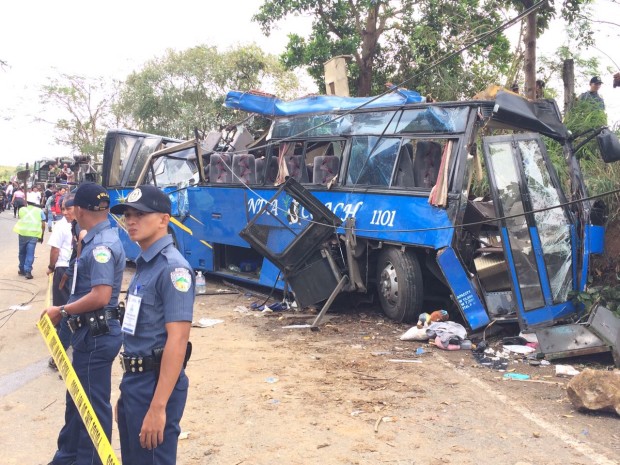Safety forum: Humanizing road crash stories can help save lives

Fifteen people died and 40 were injured after a bus hit a post in Tanay, Rizal, on Feb. 20,. 2017. (File photo by NIÑO JESUS ORBETA / Philippine Daily Inquirer)
For many journalists, road crashes are mere breaking news to be filed, produced, and narrated to the public.
But for Jacque Manabat, a crash survivor-turned-journalist, writing stories on road safety goes beyond the surface.
On Tuesday, Manabat, a reporter for more than a decade now, shared the reason for her interest in transportation issues.
“I am a road crash survivor. Twice. So I’m part of the statistics,” Manabat said during her speech at a forum, “Media and Road Safety,”organized by nonprofit media organization VERA Files, in partnership with the World Health Organization (WHO).
During the forum, VERA Files also launched its handbook for journalists who cover road safety, “Keeping our Roads Safe: A Guide for Journalists in the Philippines.”
Article continues after this advertisementThe handbook is dedicated to the memory of VERA Files trustee and journalism professor Lourdes “Chit” Estella-Simbulan, a journalist of three decades who was killed in a car crash on May 13, 2011.
Article continues after this advertisementAccidents that influenced a career
Her first road crash happened in Pangasinan when she was 13 years old. As she was about to cross a pedestrian lane with her grandmother, a speeding jeepney hit her.
From a hospital in Pangasinan, she had to be transferred to a hospital in Baguio City, about 96.4 kilometers away.
“The roads back then were not paved so the travel was eight hours, so imagine the torture my mom and I had to go through,” she said.
Then when she was 16 years old, Manabat pushed an 8-year-old boy away from the road to prevent him from getting run over by a taxi.
She saved the boy. Unfortunately, she herself was injured.
“The broken bones just made me stronger,” she said.
Those two incidents would figure in her choice of career. She went on to become a multi-platform journalist for a television network and has since been covering the transportation beat and road incidents.
“The safety of the motorists is my utmost concern whenever I look for stories,” she said. “It has become a mission, an advocacy.”
She underscored the fact that, despite present laws on road safety, weak enforcement remained a serious problem.
‘A transportation and public health issue’
According to freelance journalist Dinna Dayao, road crashes are a “serious health crisis” with more than 12,000 fatalities yearly.
In 2016, she noted, P4 trillion of the country’s gross domestic product of P15.348 trillion went down the drain.
Road accidents are also a cause for concern for Sen. J.V. Ejercito, vice chair of the Senate Committee on Public Services, and Catanduanes Rep. Cesar Sarmiento, chairman of the House Committee on Transportation.
In Metro Manila alone, one person is killed by a road crash every 17 hours, or at least 509 deaths every year, Ejercito said, citing reports from the Department of Health (DOH).
READ: Ejercito on PH road safety: A person is killed in crash every 17 hours
“We have a worrying road safety situation in the Philippines,” Ejercito said, citing a Philippine Statistics (PSA) data showing that the number deaths due to road crashes has been increasing since 2006.
“In 2006, the country registered 6,869 deaths due to road crash-related deaths. Last year, we had 32, 269,” he added.
Ejercito stressed that both lawmakers and the public should do something about the situation, insisting that road crashes could be averted.
There are several road safety laws already in place – the Land Transportation and Traffic Code of the Philippines, the Road Speed Limiter Act of 2016, the Seat Belts Use Act of 1999, the Anti-Drunk and Drugged Driving Act of 2013, the Motorcycle Helmet Act of 2009, the Children’s Safety on Motorcycles Act of 2015, and the Ant-Distracted Driving Act of 2016.
Still, Ejercito and Sarmiento have been pushing bills that could further safeguard motorists and commuters.
Among the proposed measures filed at the Senate were the Anti-Overloading Act, the Dash Cam Law, and the Child Safety in Motor Vehicles Act.
Meanwhile, at the House, lawmakers are pushing similar bills – the Traffic Crisis Act, Child Safety in Motor Vehicles Act, the creation of a National Transportation Safety Board, and the Sustainable Transport Act, Sarmiento said.
‘Weak enforcement of laws’
With all the legislative safeguards being pushed, Sarmiento said “weak enforcement of laws and low public awareness on the importance of public safety” remained reasons behind the continuous increase in road crash incidents.
“There are so many other things that can be done and should have been done to improve the implementation of our road safety laws and to heighten public awareness,” he added. “This remains our two-pronged challenge now.”
The two lawmakers and the two motoring journalists strongly believe that humanizing road crash stories – and digging deep into these narratives – could impact many lives and save many from future road crashes. /atm